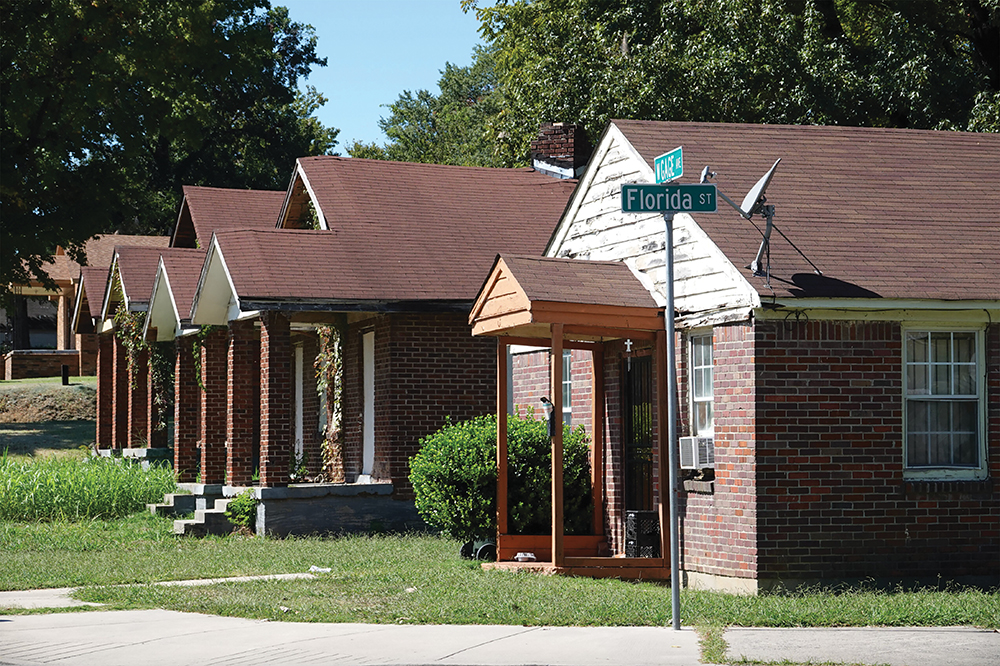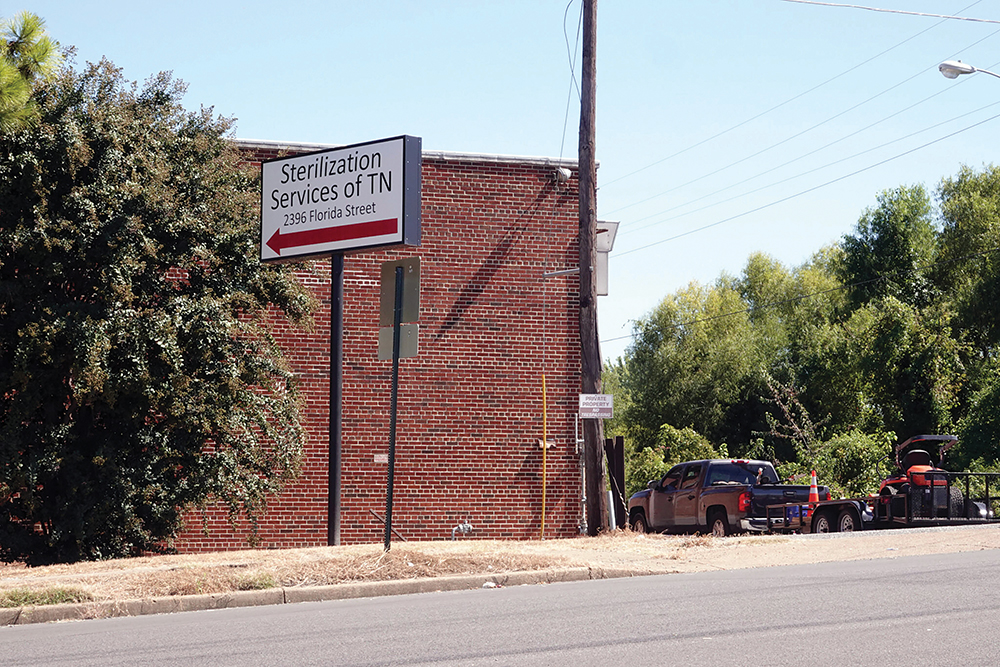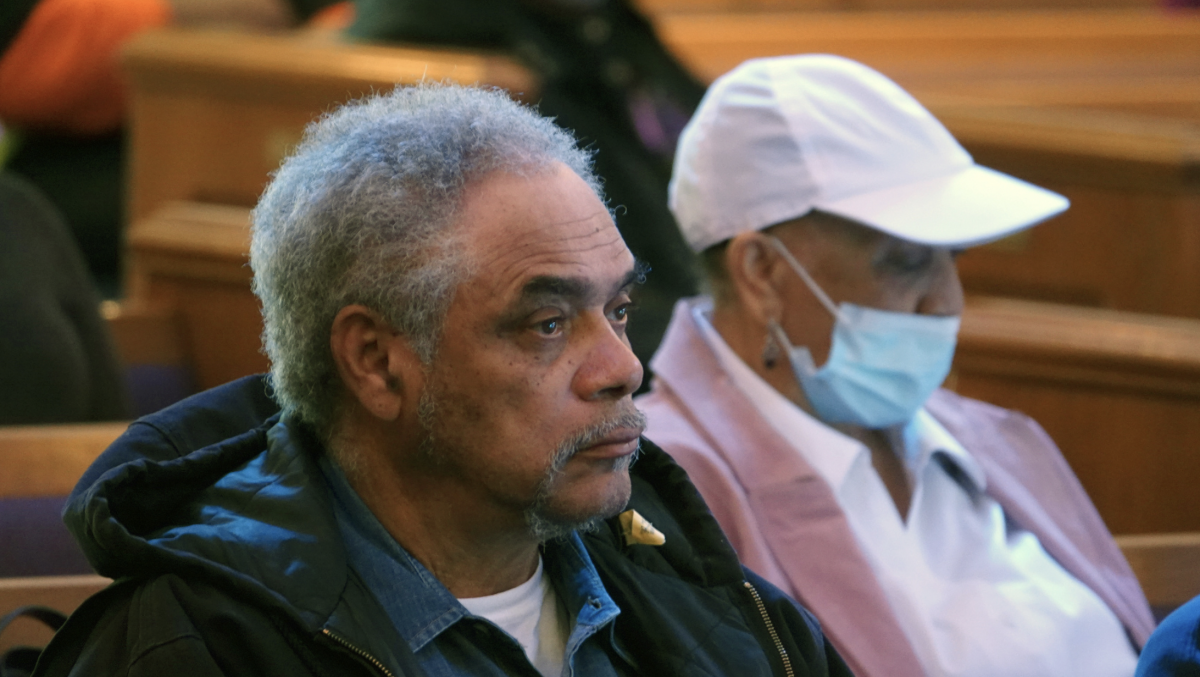Leona Golster loves her home in South Memphis, but sometimes it’s hard for the 78-year-old to breathe on her front porch.
Every now and then, the wind blows the smell of chemicals from the Sterilization Services of Tennessee (SST), a facility that uses ethylene oxide (EtO) to sterilize equipment for businesses throughout Tennessee.
“Smells like they’re burning something,” she said, pointing to the building less than a mile away from her home.
For the past few decades since the facility moved into her community, Golster has gone inside to escape the smell or wore a mask to sit outside.
Not much was known about EtO when the SST facility was founded in 1976, and the Shelby County Health Department’s air program granted the facility permits to operate in 1985. And while SST is following the U.S. Environmental Protection Agency’s current rules and regulations, officials have since learned that a lifetime of exposure to EtO, a known carcinogen, could lead to long-term health impacts should current emissions continue.

Once, the smell bothered her, but “not like it used to,” she said.
She loves her home, a one-story brick house. She moved into this house in the 1960s after marrying a man she met at a club.
“He was a man, I tell you. He was a booga bear,” she recalled.
She raised her children there, three of whom are now deceased. Her two oldest daughters died from health complications as adults.
“She never did stop working,” she said of her second-oldest daughter. “We went to church, that Sunday she came home and died that evening. I gave her to the Lord, I said there ain’t nothing I can do, that’s God’s doing.”
Her youngest daughter died of pneumonia at 4 years old.
And since her husband died from a work-related accident seven years ago, Golster has lived alone, enjoying the quiet, seemingly abandoned neighborhood. Many houses are in disrepair, while others have been gutted.
After becoming aware of new information on EtO, the EPA announced outreach efforts to the communities living near the SST facility to inform them of the dangers in constant EtO exposure. EPA officials met with residents on October 18th.

About 292 households are located near the facility, according to the Memphis Community Against Pollution (MCAP). Although the EPA is supposed to be doing outreach to the neighborhood, MCAP volunteer Angela Johnson found few residents that knew about EtO or the EPA’s current involvement.
“If you don’t know it’s there, you don’t know it’s there,” she said.
As for Golster, she is often annoyed by calls asking to purchase her house, which she intends to live in for as long as she can.
“I stay to myself. I’ve been here for a long time. Nobody bothers me,” she said.
The toxic effects of EtO
EtO, a colorless and flammable gas, has long been used to make other chemicals and products like antifreeze and plastic bottles, as well as sterilizing medical equipment and some spices to prevent contamination from bacteria and viruses, according to the EPA. And while EtO emissions at permitted levels today were not considered dangerous, studies have since shown that a lifetime of exposure could lead to long-term health impacts, including elevated cancer risks.
Breathing air containing EtO is the main method of exposure, since it is unlikely to remain in food or remain dissolved in water long enough to be eaten.
As a known human carcinogen, studies found that years of exposure to EtO could lead to non-Hodgkin’s lymphoma, myeloma, and lymphocytic leukemia. For women, long-term exposure increases the risk of breast cancer.
Growing up around EtO can lead to devastating effects for children.
Studies have shown that as children’s bodies develop and grow, they are much more susceptible to the toxic effects of EtO. As a mutagenic, EtO can damage DNA and can lead to long-term neurological effects.
And because children are likely to play outside more often than adults are outside, they are more exposed to EtO, said Courtney Roper, assistant professor of environmental toxicology at the University of Mississippi.
Since the EPA is now investigating the negative impacts of EtO, changes in regulations may follow. The EPA announced its intentions to propose strengthening current regulations around EtO while taking into account risk to those exposed.
But this could take years, said Roper.
“It’s not going to be like, ‘Oh, tomorrow you have to change this,” even when regulations are in place, since facilities are given a set amount of time to kind of get into compliance,” she said.
And while some facilities across the country are already working to reduce EtO levels and working with local and state health departments, said Roper, SST has not indicated it will do the same.
An SST spokesperson offered no comment when this story originally ran early last month.
So you live near a toxic chemical plant, now what?
The larger picture of course, said Roper, is how environmental racism remains a factor in South Memphis. Memphis, a majority-minority city, has for decades carried the burden of housing area industries emitting pollution.
Over the past two years, Memphis Community Against Pollution, previously known as Memphis Community Against the Pipeline, gained national attention for resisting construction of the Byhalia Pipeline and for efforts to use eminent domain in a historically Black community to acquire the necessary property.
Critics of the Byhalia Pipeline accused the developers of following a playbook for environmental racism by targeting Black neighborhoods that seemingly lacked the political power of wealthier, primarily white areas.
Although plans for the Byhalia Pipeline were withdrawn, the environmental justice movement drew attention to the repeated pattern of industries producing pollutants operating in low-income, predominantly Black neighborhoods.
In Memphis there are 66 facilities contributing to cancer rates four times higher than the national average, with half located in South Memphis, according to the Energy News Network.
The area also has high asthma rates, has been deemed a hot spot for air pollution, and has received a failing grade in terms of air quality from the American Lung Association.
The SST facility is among those polluting factors, and while the EPA is currently conducting community outreach and planning to inform residents about the dangers of EtO exposure, it did not indicate what other actions will be taken beyond changes in regulations.
Once residents are made aware, the low-income community will most likely be unable to leave their homes to avoid further exposure.
“That’s the environmental justice aspect of situations like this, where individuals that don’t have the desire or ability to move from being near that facility are kind of like, ‘Well, I live by a facility that may be causing cancer,’” said Roper.
“So it’s definitely a challenge and there are no resources that I am aware of in place to support something like individuals moving after getting notice of this. It’s more on a federal side of just letting people know of the situation than tangible funds to change it,” she added.
And right now, the SST facility is in compliance with federal and state regulations, “so there’s no way to enact an expectation that they pay people to move,” she said.
Without changes in regulations, consistent pressure from community groups could enact swifter change. MCAP members and volunteers are currently enacting their own outreach efforts in South Memphis to alert neighbors. Roper has been collaborating with MCAP in learning more about the effects of EtO.
Memphis officials and the Shelby County Health Department are also working to alert residents and collaborating with the EPA.
“Shelby County Health Department has requested a cancer incidence study of the area surrounding the Sterilization Services of Tennessee facility from the Tennessee Department of Health to identify any higher-than-expected cancer rates among the population in that community,” said spokesperson Joan Carr, when she urged concerned residents to attend the EPA’s public meeting.
A home near a polluting plant is still a home.
Although Golster was unaware of the negative effects simply by living near pollution, she doesn’t plan on leaving any time soon.
Most recently she celebrated her 78th birthday and her grandson paid for her nails to be done. She proudly sat on her porch next to empty chairs, showing off her brightly colored nails and braided hair.
Her 11 grandchildren often come by for a visit, so she is not often alone.
“They some booga bears too,” she said.
EPA to South Memphians: Leaving your homes is the best option.
At Monumental Baptist Church in South Memphis, local residents lined up to tell federal officials how cancer possibly linked to their environment had taken their loved ones, friends, and family.
EPA officials flew into town to inform residents of the possible deadly consequences of living near Sterilization Services of Tennessee, a facility that has been located in the neighborhood since 1976.
The company uses EtO to sterilize items as disparate as medical equipment and spices. It operates under the necessary federal and local permits and no protective measures are required to prevent EtO from escaping into the nearby community, including those who worked nearby and children who attended nearby schools.
But in the last few years, EPA officials have learned that EtO was more dangerous than they previously knew. Breathing the chemical may have increased the risk for cancer and other health risks, with risk increasing due to proximity.
Children are also more susceptible, said Daniel Blackman, an EPA administrator responsible for overseeing four states, including Tennessee.
Controlled emissions are regulated by equipment designed to prevent EtO from escaping the facility, but fugitive emissions — or emissions that escape the facility — cause the most risk and are not covered under current regulations.
“Risk in Memphis is high and we’re very concerned about that risk,” said Blackman.
EPA officials also noted how there was little residents could do to minimize their risk beyond leaving their homes in South Memphis. There are no air filters that could protect them inside or outside their homes, and spending more time indoors does not reduce their risk.
“The best solution to reducing this risk is to reduce the amount of currently not regulated EtO, fugitive emission that is going out of this facility,” said Caroline Freeman, EPA air and radiation division director.
“As a matter of fact, spending less time near the facility would in fact reduce your risk,” she added.
On October 18th, EPA officials addressed residents’ concerns. The Shelby County Health Department director, Dr. Michelle Taylor, also attended.
As soon as the presentation was finished, residents from the affected neighborhoods, Riverside and Mallory Heights, left their church pews to stand in line and address the EPA officials directly.
Maxine Thomas, a South Memphis resident, walked to the microphone, carefully balancing on her cane as she asked how residents were expected to protect themselves.
“What are we going to do? Just die?” she asked. “I want to live a long life. I’m 83 years old.”
Another resident told officials she was born and raised near Sterilization Services of Tennessee, and she lived close enough that she could throw a rock at the building from her backyard. Although she later moved away, she later developed breast cancer, and several of her neighbors had also have had cancer.
“Some of us have lost parents. I lost my father,” said resident Carolyn Lanton.
Due to the cancer risks, EPA officials and the Shelby County Health Department are looking into how many cancer cases were connected to the residents in the area. The department is also working on creating resources for residents without the means to get tested for cancer, said Taylor.
“We are already working with all of our hospital partners in deep conversations about the number of resources that we will be able to bring there. We know that there are a lot of people in the community who are either uninsured or underinsured, don’t forget about that,” said Taylor. “So we have a lot of people, and a lot of that has to do with what’s going on at the state level, the fact that we are not a Medicaid expansion state. Don’t get me started on that.”
The EPA is also planning to propose new regulations targeting EtO emissions in the coming months, and a final proposal is expected in 2023. Once the regulations are set, the Clean Air Act allows facilities two to three years to comply with the requirements and the EPA has been encouraging facilities to work on reducing current emissions levels.
But residents asked why they were still being asked to take on the risk of living near a cancer-causing facility that only employed eight workers, they noted. Others complained that EPA officials had offered few solutions.
“We need something done now. We can’t keep dying for some [profit],” said Adrian Ward, a resident.
“We don’t need nothing but a solution to the problem. Ask them to move somewhere else less populated,” he added.
The problem is, said EPA officials, that Sterilization Services of Tennessee has not broken any regulations and has all the necessary permits. While the facility is one of 100 in the nation, the Memphis facility is one of 23 with higher risk — and no law prevented the facility from moving into a primarily low-income, Black community, a notion that many community activists have labeled as environmental racism.
“We have been dying disproportionately, and what we’re being told is to wait. We can’t afford to wait,” said Justin J. Pearson, co-founder of Memphis Community Against Pollution. “It’s that we are being sacrificed for polluters. We are being sacrificed for their profits, and we are being sacrificed because people in positions of power are not caring about our lives.”
“The Sterilization Services has got to go,” he said.
“It’s easy for you to say what you said, and I agree with the majority of why people are here. I think the challenge is that’s not how this process works,” Blackman retorted, adding that communities needed to challenge local zoning laws in order to make the facility move.
Pearson then addressed the EPA panel directly about their efforts to inform the community about the risks they inherited just by living in South Memphis.
“You have failed to adequately inform this community of what’s going on,” he said, adding that MCAP volunteers sent out thousands of flyers and text messages.
The community cannot wait on new regulations, said Pearson, and MCAP planned on continuing mobilization efforts to enact swifter changes.
“This is the movement that we’re talking about, and we need you to go back to Atlanta and do your job well and know that you’ve got Memphis to support you,” he said.
“But we don’t have time to wait,” said Pearson.
This story was written by Dulce Torres Guzman for Tennessee Lookout and originally published on tennesseelookout.com in two parts, which can be found here and here.



